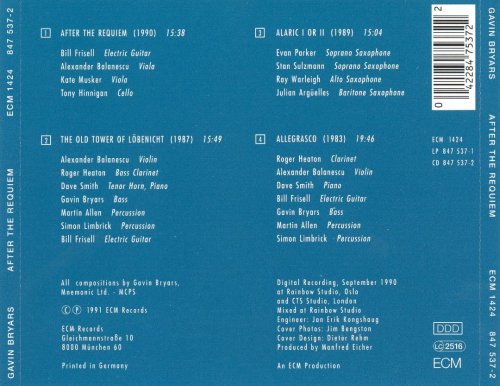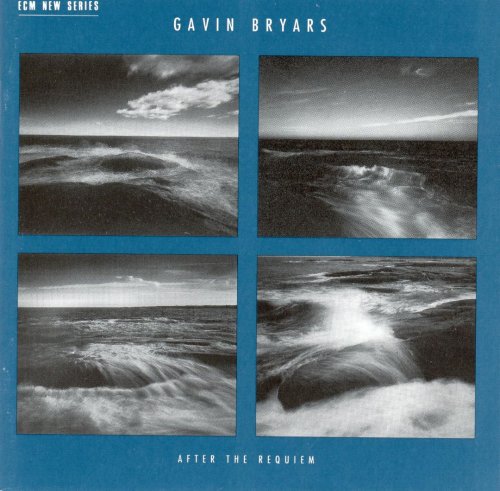
Gavin Bryars - After the Requiem (1991) CD-Rip
BAND/ARTIST: Gavin Bryars
- Title: After the Requiem
- Year Of Release: 1991
- Label: ECM New Series
- Genre: Classical
- Quality: FLAC (image+.cue,log,scans)
- Total Time: 01:06:17
- Total Size: 315 Mb
- WebSite: Album Preview
Tracklist:
1. After the Requiem (1990)
Bill Frisell, electric guitar
Alexander Balanescu, viola
Kate Musker, viola
Tony Hinnigan, cello
2. The Old Tower of Lobenicht (1987)
Alexander Balanescu, violin
Roger Heaton, bass clarinet
Dave Smith, tenor horn, piano
Gavin Bryars, bass
Martin Allen, percussion
Simon Limbrick, percussion
Bill Frisell, electric guitar
3. Alaric I or II (1989)
Evan Parker, soprano saxophone
Stan Sulzmann, soprano saxophone
Ray Warleigh, alto saxophone
Julian Argüelles, baritone saxohpone
4. Allegrasco (1983)
Roger Heaton, clarinet
Alexander Balanescu, violin
Dave Smith, piano
Bill Frisell, electric guitar
Gavin Bryars, bass
Martin Allen, percussion
Simon Limbrick, percussion

1. After the Requiem (1990)
Bill Frisell, electric guitar
Alexander Balanescu, viola
Kate Musker, viola
Tony Hinnigan, cello
2. The Old Tower of Lobenicht (1987)
Alexander Balanescu, violin
Roger Heaton, bass clarinet
Dave Smith, tenor horn, piano
Gavin Bryars, bass
Martin Allen, percussion
Simon Limbrick, percussion
Bill Frisell, electric guitar
3. Alaric I or II (1989)
Evan Parker, soprano saxophone
Stan Sulzmann, soprano saxophone
Ray Warleigh, alto saxophone
Julian Argüelles, baritone saxohpone
4. Allegrasco (1983)
Roger Heaton, clarinet
Alexander Balanescu, violin
Dave Smith, piano
Bill Frisell, electric guitar
Gavin Bryars, bass
Martin Allen, percussion
Simon Limbrick, percussion
What a disconcerting composer Gavin Bryars is. One moment he is producing music of hypnotic individuality, the next he seems to offer only triteness and tedium. Such have been my experiences with, respectively, the previous ECM compilation of chamber works which I reviewed in March 1987, and the performance of his 'conceptual' piece The Sinking of the Titanic at the Huddersfield Festival of Contemporary Music last November. Is the quality of his work entirely in the mind of the beholder? Is it actually very variable? Does it just come across best in private and without visual distractions? Maybe it has vestiges of the contempt for all value judgement which held such appeal in the 1960s.
We can only speak as we find, and for me After the Requiem, placed first on this new issue, renewed much of the spell of Bryars's strange musical personality. For electric guitar and string trio it starts in euphonious ten-second bursts, gradually coheres into longer lyrical lines, and takes wing in the later stages. Again speaking personally, there is a quality of urban melancholy behind the notes which redeems it from any possible charge of not having 'grown up' (the language is of a Satiesque simplicity).
All the same, I found it impossible to sustain interest throughout the other pieces. The Old Tower of Lobenicht (inspired by Thomas de Quincey's The Last Days of Immanuel Kant) moves from impressive bass-register exhalations into arpeggiated doodlings, a kind of GCSE pandiatonicism which aspires to Poulencian memorability but never makes it. The saxophone quartet Alaric I or II (after a mountain in south-west France commemorating one or other Visigoth King by that name) goes in for multiphonics and distortions of intonation which stick out like so many sore thumbs. These remain unassuaged by the glimpses of Victoriana near the end, but the piece may still have some appeal for those who prefer their minimalism messy rather than slick. Finally Allegrasco (after Edmondo Allegra, dedicatee of clarinet works by Busoni) squanders its promise with some half-hearted forays into harmonic complexity.
A mixed bag then, all of it extremely well played (though I reserve judgement in the case of the saxophone quartet) and vividly recorded (rather too vividly for comfort unless you turn the volume well down).'
We can only speak as we find, and for me After the Requiem, placed first on this new issue, renewed much of the spell of Bryars's strange musical personality. For electric guitar and string trio it starts in euphonious ten-second bursts, gradually coheres into longer lyrical lines, and takes wing in the later stages. Again speaking personally, there is a quality of urban melancholy behind the notes which redeems it from any possible charge of not having 'grown up' (the language is of a Satiesque simplicity).
All the same, I found it impossible to sustain interest throughout the other pieces. The Old Tower of Lobenicht (inspired by Thomas de Quincey's The Last Days of Immanuel Kant) moves from impressive bass-register exhalations into arpeggiated doodlings, a kind of GCSE pandiatonicism which aspires to Poulencian memorability but never makes it. The saxophone quartet Alaric I or II (after a mountain in south-west France commemorating one or other Visigoth King by that name) goes in for multiphonics and distortions of intonation which stick out like so many sore thumbs. These remain unassuaged by the glimpses of Victoriana near the end, but the piece may still have some appeal for those who prefer their minimalism messy rather than slick. Finally Allegrasco (after Edmondo Allegra, dedicatee of clarinet works by Busoni) squanders its promise with some half-hearted forays into harmonic complexity.
A mixed bag then, all of it extremely well played (though I reserve judgement in the case of the saxophone quartet) and vividly recorded (rather too vividly for comfort unless you turn the volume well down).'

Classical | FLAC / APE | CD-Rip
As a ISRA.CLOUD's PREMIUM member you will have the following benefits:
- Unlimited high speed downloads
- Download directly without waiting time
- Unlimited parallel downloads
- Support for download accelerators
- No advertising
- Resume broken downloads


